Well water treatment: popular and affordable methods
It is not a secret that a well in a country plot is the most accessible and effective way of autonomous water supply. But in order for the water to be drinking for a long time, regular water purification from the well will be needed.
How to bring the contents of the well in proper condition with minimal cost? We will tell about it within this article.
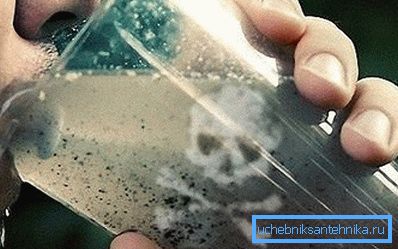
Changes in the initial characteristics of water: causes and ways to eliminate
Well water treatment can be triggered by a number of reasons, including:
- clouding;
- the appearance of uncharacteristic color;
- the appearance of taste and odor.
Let's try to find out what causes these undesirable phenomena and what needs to be done so that the clean water in the well is constant.
- Turbid water is, most often, a consequence of the violation of the integrity of the seams and joints of the walls of the water intake shaft. After the tightness of the walls is broken, soil particles that are dissolved in a liquid medium enter the water from the outside. Turbid water in the well after cleaning becomes transparent only for a certain time. To avoid subsequent contamination, it is necessary after inspection to inspect the walls of the mine and restore their tightness.
- The appearance of uncharacteristic color can be caused by a number of different reasons, among which are pollution of the water intake and pollution of the aquifer.
- If the water intake shaft is polluted, the water may become black due to the fact that organic elements that have fallen into the well decompose. Also, water can become green due to the rapid proliferation of algae. In this case, the only effective method is disinfection and complete water purification in the well.
Important: The effect of the measures taken will be more durable if a reliable canopy is made above the well. Moreover, the barrel should be equipped with a special lid or hatch, which will prevent the likelihood of foreign objects and debris.
- When the aquifer is polluted, the water acquires a characteristic yellowish color. This color indicates that the concentration of iron in the water is exceeded. And to decide how to clean the water from iron in the wells of this situation will help the use of an external water treatment system.
- The appearance of taste and odor can be triggered by a compound of iron and a number of metals, organic impurities that decompose and release hydrogen sulfide. The presence of a sweet taste indicates the presence of nitrogen compounds in water. The solution is to check and repair the roof over the well with your own hands.
Features of cleaning the well
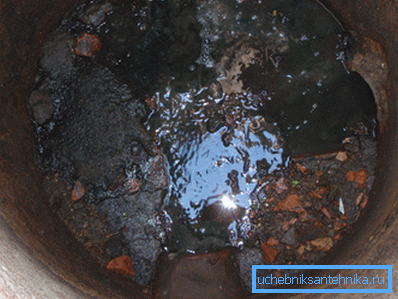
In order for the quality of the inputs in the well to be satisfactory, it is necessary to clean the walls of the water intake shaft from mucus annually due to the active multiplication of bacteria. It is also necessary to remove the accumulated debris and silt from the bottom..
So, how and what to clean the water in the well?
Cleaning the barrel is a complex of works that should be carried out in the following sequence:
- We pump out water from the well with a powerful drainage pump.
- We carry out mechanical cleaning of the trunk from bacterial accumulations.
- We disinfect the walls of the mine.
- Remove trash and sludge from the bottom.
- Carefully close up cracks, gaps, joints, install brackets in order to prevent the displacement of concrete rings.
- We carry out a survey and, if necessary, perform the replacement of the bottom filter.
Pumping water from the barrel
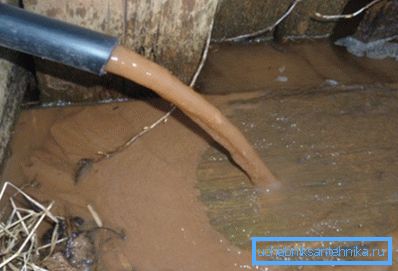
The contents of the well, which has not been cleaned for several years, can only be pumped out with a drainage or fecal pump. An ordinary household pump, for example, the popular "Spring", will quickly fail due to multiple clogs.
For pumping water, you can use equipment of the submersible or surface type. But in order for the work to be performed in automatic mode, it is advisable to use a submersible pump with a float shutoff mechanism.
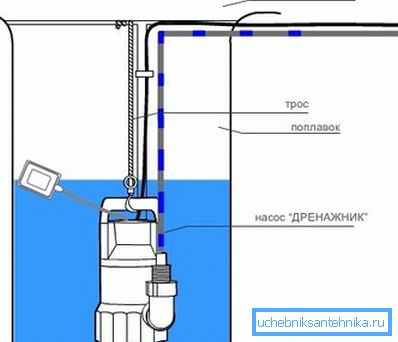
Mechanical cleaning of bacterial clusters
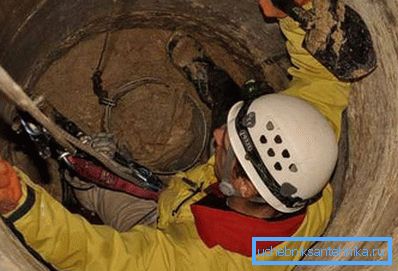
After all the water is pumped out, we lower the ladder into the well and go down to the bottom. Literally from the very bottom to the half of the trunk, all the walls are covered with a coating of consistency resembling mucus. The task is to armed with a stiff brush, remove this raid without a trace.
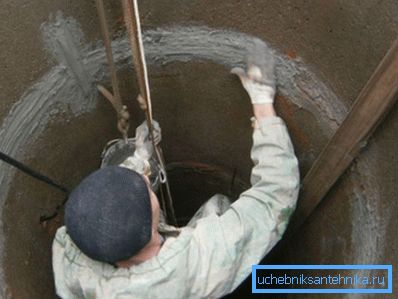
Instructions for cleaning implies increased caution, as in conditions of high humidity the steps need to be tied up with a rope, the free end of which must be kept by a couple of people on top.
Bottom filter maintenance
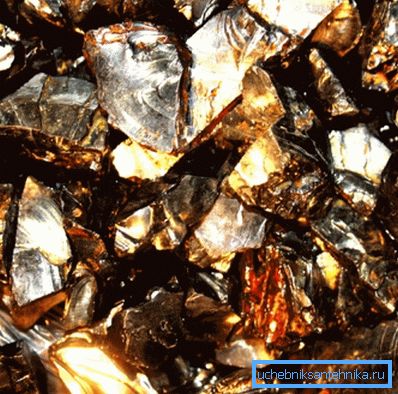
As a rule, the bottom filter is an 8-10 centimeter layer of gravel and silicon. This layer can be supplemented with inclusions of some natural sorbents such as, for example, zeolite. Such filling of the well has high filtering parameters, in addition, its price is low. Therefore, this type of filter effectively purifies water, both from organic impurities and from heavy metals.
In the process of routine cleaning of the well, the layer of the old dirty filter is completely selected and washed in clean running water. A layer of cleaned gravel is laid on the bottom and leveled.
To achieve maximum efficiency, the filter can be supplemented with a layer of shungite. Shungite for water purification in the well is an absorbent, which, passing through water, absorbs dissolved contaminants.

Important: It is possible to apply shungit both as a backfill to the bottom of a dried mine, and as a backfill in a well being operated. That is, when you find that the water is not clean enough, you just fall asleep shungite in the mine. As the backfill sinks to the bottom, it absorbs impurities. As a result, the water after the procedure will be clean. But this method is applicable only for minor contamination, if the pollution is more substantial, one cannot do without serious cleaning.
Water disinfection
After cleaning and repairing the barrel is over and the bottom filter is replaced or put in proper condition, it's time to start disinfecting the water.
There are several more or less effective ways to clean the liquid from pathogens, but the most simple and affordable method is the use of bleach.
For disinfection we produce a 20% solution.
We do this as follows:
- In an enamel or glass container pour 1 liter of cold water;
- Fall asleep in a capacity of 200 grams of bleach;
- Gently mix the solution with a plastic spoon or stick;
- Capacity tightly cover the lid and leave for a couple of hours to the solution was settled.
Important: you can not use warm water to prepare a solution, since chlorine vapors will quickly evaporate.
The finished solution is suitable for wiping the walls of an empty water well, and for adding to the water. After the solution is poured into the well, tightly close the barrel with a lid so that chlorine vapors do not erode. After 24 hours, we open the mine hatch and pump out all the water from the well.
As the barrel is filled with fresh water, we take trial fences. If the smell of chlorine remains, the water is pumped out again and so on until the smell is completely absent.
Preventive chlorination of water
In order to eliminate the likelihood of the development of pathogens in well water, it is advisable to carry out preventive chlorination with an intensity of about once every six months.
The essence of the process is that it is necessary to add just enough bleach to the wellbore so that the water becomes a one-percent bleach solution. Insignificant concentration on the one hand will stop the development of microorganisms, and on the other hand will not require the replacement of the entire volume of water.
The most difficult to clear the amount of bleach, which will provide the desired concentration. As a rule, for the desired effect, a concentrated solution of chlorine is added with a medical pipette for 1 cubic meter of water, 20 drops (800 ml). If the concentration of bleach is exceeded, it will take more time for the chlorine fumes to evaporate without residue.
Conclusion
Now you know how to clean water from the well is simple and inexpensive. But it is not necessary to bring the water intake mine to the state when capital cleaning is required, because it is always easier to prevent pollution than to completely eliminate it. Find more useful and interesting information by watching the video in this article.